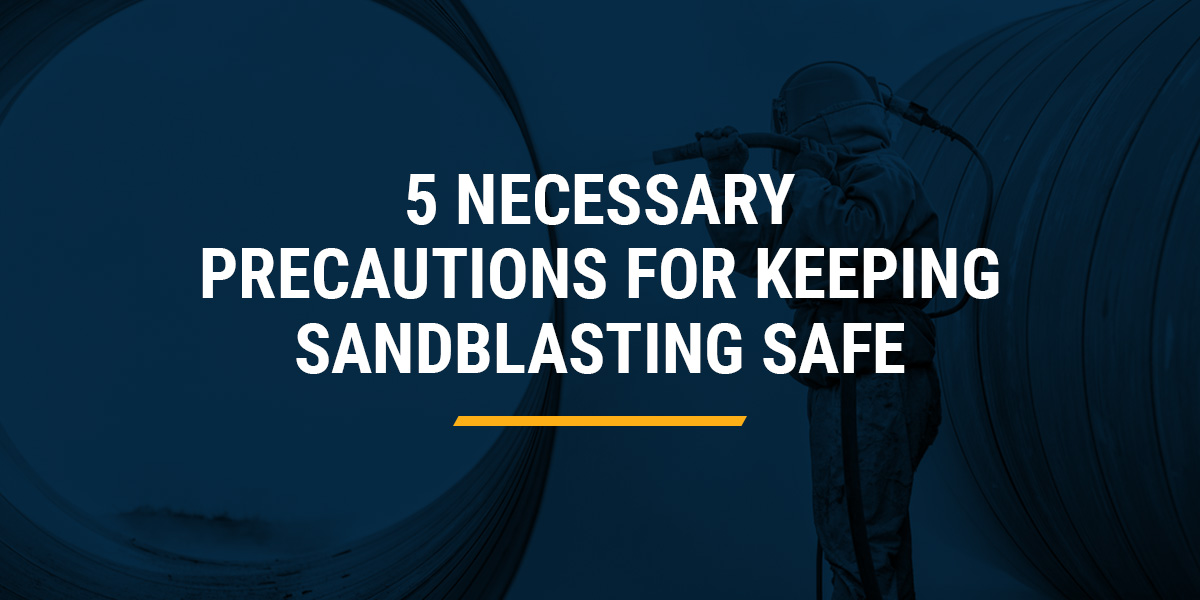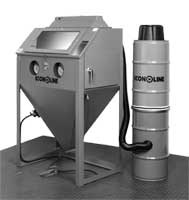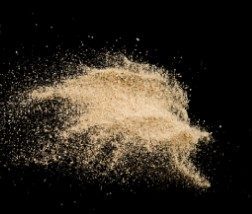
5 Necessary Precautions for Keeping Sandblasting Safe
Updated: December 22, 2023Sandblasting, or “abrasive blasting,” is the process of directing tiny abrasive particles with compressed air or water to create a high-velocity stream that smooths surfaces, removes jagged edges or burrs, applies texture to a material or prepares a surface for coating. Due to the safety risks involved, this process should always be performed in a controlled environment by trained professionals. In addition, employers are responsible for providing these workers with the necessary safety equipment.
Keeping sandblasting safe involves protecting workers from the immediate hazards of the high-intensity blasting process and the residual toxins released during the blasting media sessions. OSHA requires blasting facilities to follow certain safety protocols to keep workers safe during and after the sandblasting process, and you can also provide your personnel with additional sandblasting safety tips suited to your specific equipment and processes.
5 Guidelines and Safety Tips for Blasting Processes
Sandblasting can be hazardous both for those performing it and those nearby. To ensure that workers can perform abrasive blasting tasks safely, employers should follow this sandblasting safety checklist:
1. Secure the Environment
- Eliminate tripping and falling hazards. It’s crucial that you keep the blasting area free of unnecessary items and substances that could lead to slipping, tripping and falling.
- Prohibit activity that could endanger workers. Blasting particles pose serious respiratory and other health hazards, so no one should be eating, drinking or smoking around the blasting areas.
- Ensure a properly functioning blasting area. Verify that all ventilation, air compressors, power supplies and wash stations are fully functional.
2. Check the Blasting Equipment
- Look for cracks and other damage. Make sure all abrasive blasting stations are damage-free and won’t leak toxins into the air.
- Check the blast hose. Ensure that there are no leaks or cracks in the blast hose.
- Use less toxic abrasives. While no abrasive material is completely harmless, you can improve safety by using materials lower on the toxicity spectrum when possible.
- Use proper containment practices. Keep the blasting equipment in proper containment structures, and keep any non-enclosed blasting areas restricted.
- Test breathing filters and carbon monoxide monitors. These items must be checked on a daily basis to confirm that the area will be properly ventilated, thus lessening the overall toxicity of the blasting environment.
3. Ensure Protective Gear Is Available
- Give your blasting workers the proper protective garments. Sandblasting safety measures require that workers wear protective helmets, clothing, gloves, safety footwear, earplugs, safety goggles and other OSHA-recommended equipment.
- Provide workers with proper respiratory equipment. Respiratory protection is absolutely critical for sandblasting processes. Anyone using the blaster must be wearing an abrasive blasting respirator that covers that person’s head, face, neck and shoulders. Moreover, the respirators need to be NIOSH-certified. Workers involved in the cleanup process may also need respiratory equipment.
4. Use Proper Cleanup Procedures
- Clean the area with water. Post-sandblasting cleaning processes must involve water-based cleaning methods or HEPA-filtered vacuuming systems.
- Avoid using concentrated air cleaning methods. Using compressed air as a cleaning agent will only disperse more dust into the environment.
5. Invest in Thorough Training
- Train blasters and support staff on sandblast safety standards. Your workforce should know the risks involved with sandblasting and the measures required to stay safe. Consider developing a comprehensive plan that ensures they understand how to operate the machinery safely and what personal protective equipment they must wear.
- Review safety data sheets with your employees. Under OSHA standard 1910.1200, all abrasive media manufacturers must provide relevant information on the health hazards of the specific blasting materials they sell. You should go over this information with your blasting workforce to ensure they recognize the potential dangers.
Hearing Damage
Abrasive blasting also generates substantial environmental noise. With excess exposure, significant hearing loss can occur. This potential risk makes enforcing safety precautions like hearing protection use even more important. OSHA standard 1910.95 requires most sandblasting employers to implement a hearing conservation program that may include regular monitoring and testing.
Is Sandblasting Safe?
Sandblasting is a hazardous process that requires extensive training and OSHA-compliant equipment. However, while there is potential for danger, sandblasting media can be performed safely as long as the proper protocols are followed at all times.
Before the first steps of the sandblasting process begin, supervisors and other essential personnel need to inspect the sandblasting equipment, the working environment and the sandblasting workers’ protective gear for any damage or abnormalities that could lead to safety issues. Otherwise, the consequences of improper safety measures could lead to serious injury and a number of health problems for workers near the blasting area.
Is There Special Sandblasting Safety Equipment?
Thanks to recent advancements in sandblasting safety technology, employers have access to many different types of abrasive safety equipment. From high-end respirators to durable safety overalls, footwear and gloves, sandblasting safety equipment is easy to obtain.
If you’re looking to outfit your workforce with top-quality, long-lasting sandblasting safety equipment, contact Finishing Systems today and browse our extensive safety equipment collections.

